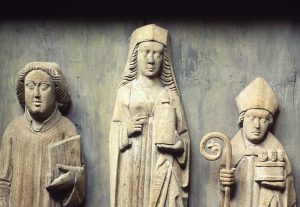Mapping medieval sculptures: Part 1. Tracking wooden saints from Finnish museum databases
Postat den 17th January, 2024, 15:16 av Sofia Lahti
Sofia Lahti, Tampere University
In 2021, I set out to complement the Mapping Saints database with medieval sculptures and other objects related to saints from Finnish churches and museums. As the principle of this database requires, the objects have to be pinned to a physical place – either a specific church, even a specific altar, or a more general area in a diocese. The location data can be registered as certain or uncertain, and with movable objects such as sculptures, altarpieces or reliquaries, this uncertainty is extremely relevant.
Some of these objects are currently in churches – they may have stayed in the same church since the Middle Ages, or have been sold or donated from one church to another, or they may have been sold or donated to a museum and later on deposited again in the church. In many cases, the itinerary of these objects can be tracked from the nineteenth century onwards, but it is often impossible to verify their medieval location. Even if extant medieval written sources indicate the presence of a sculpture of the same saint in the church, it is not water-tight proof that the sculpture currently in that church is the same one. As art historian Katri Vuola has recently remarked, another challenge in trying to track the post-medieval itineraries of medieval sculptures in Finland is that the relevant sources exist in various different archives of parishes, museums and other actors, and are often not systematically organised.[1]
More than a third of the circa 800[2] surviving medieval sculptures in Finland are currently in museums, either on display or in storage. In most cases, the museums have documentation of their acquisitions from churches, but even among these, there are a few sculptures whose acquisition documents and other provenance data has gotten lost at some point. An excellent article was published last year by researcher Ninna Pulli about the acquisition history of the medieval sculptures in the Museum Centre of Turku. By combining and combing through various archival sources, she was able to track the acquisition processes of 43 sculptures out of the 54 in their collection.[3]
The National Museum of Finland and the Museum Centre of Turku have published good-quality photographs of their medieval sculptures or altarpieces online in the Finna portal for Finnish archives, libraries and museums. Several other museums are in the process of bringing their collections into Finna as well. Meanwhile, some museums have made accessible online versions of their collections databases, but there are also museums whose collections are not viewable online at all. I contacted the Finnish regional museums to ask for an access to their collections databases in order to see what kind of information they had registered about the medieval sculptures or other saint-related objects.

While some of the objects are well documented and may have been studied by several researchers during the last couple of centuries, many medieval objects are registered without much information. Even some of the objects in Finna are published without some relevant information such as size or known provenience. During my postdoctoral period in the Mapping Saints project, I did not have the time to dig much deeper into individual objects, but new information is constantly produced by ongoing research, particularly by art historians like Elina Räsänen and Katri Vuola, who are specialists in medieval wooden sculptures in Finland.
In this series of four blog posts, I will introduce and discuss two examples of the challenges met when studying medieval images of saints in the collections databases of Finnish regional museums. It is important to underline here that the museums are not to be blamed for the challenges related to these cases; the challenges are simply results of uncontrollable past circumstances. Also, these cases are not representative of the Finnish material in general – on the contrary, both are unusual – but nevertheless demonstrative of some of the obstacles in the process. One essential thing they have in common is that there is hardly any provenience data. One of the cases concerns an extant image, while the other is a group of images that no longer exist; both examples are registered as belonging to a post-medieval church, but both of those churches have since been destroyed.
[1] Vuola, Katri 2023, Esinefragmentteja hartaudellisesta menneisyydestä. Puiset polykromiveistokset Turun hiippakunnassa pitkällä 1300-luvulla. Helsinki: Helsingin yliopisto, p. 15.
[3] Pulli, Ninna 2023, Lahjoitettuja, ostettuja, toimitettuja Keskiaikaisten pyhimysveistosten hankinnat Turun kaupungin historialliseen museoon. Suomen museo / Finskt museum vol. 129/2022, p. 130–152.
Det här inlägget postades den January 17th, 2024, 15:16 och fylls under Sculpture

